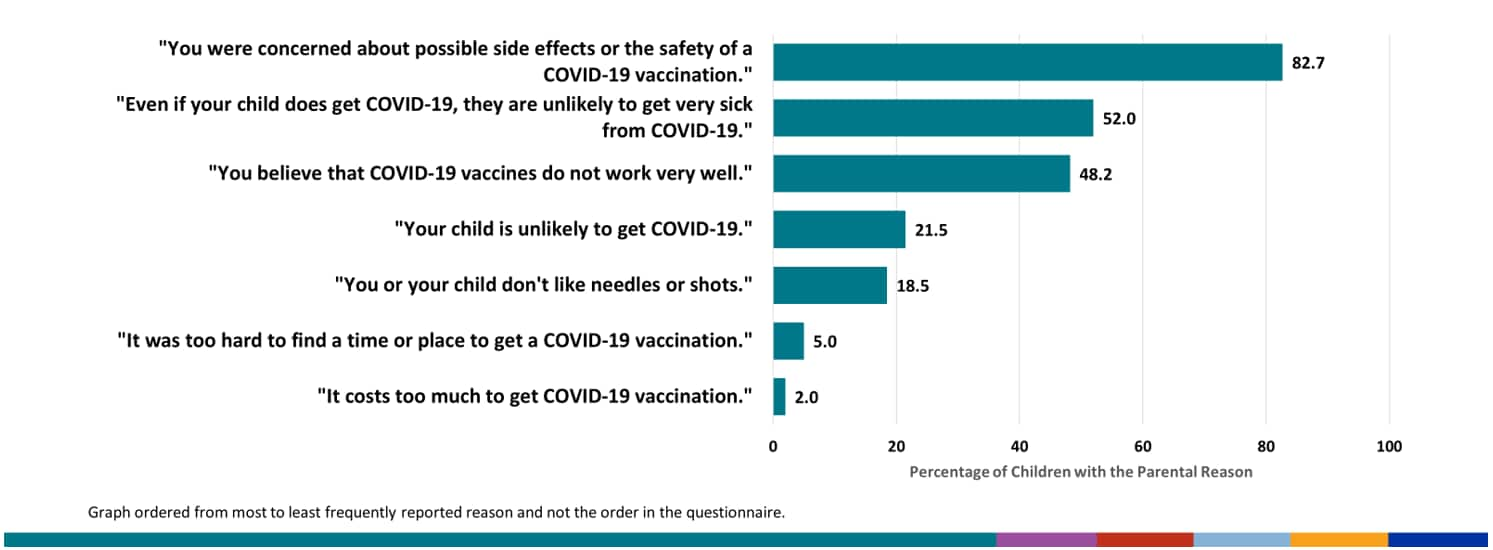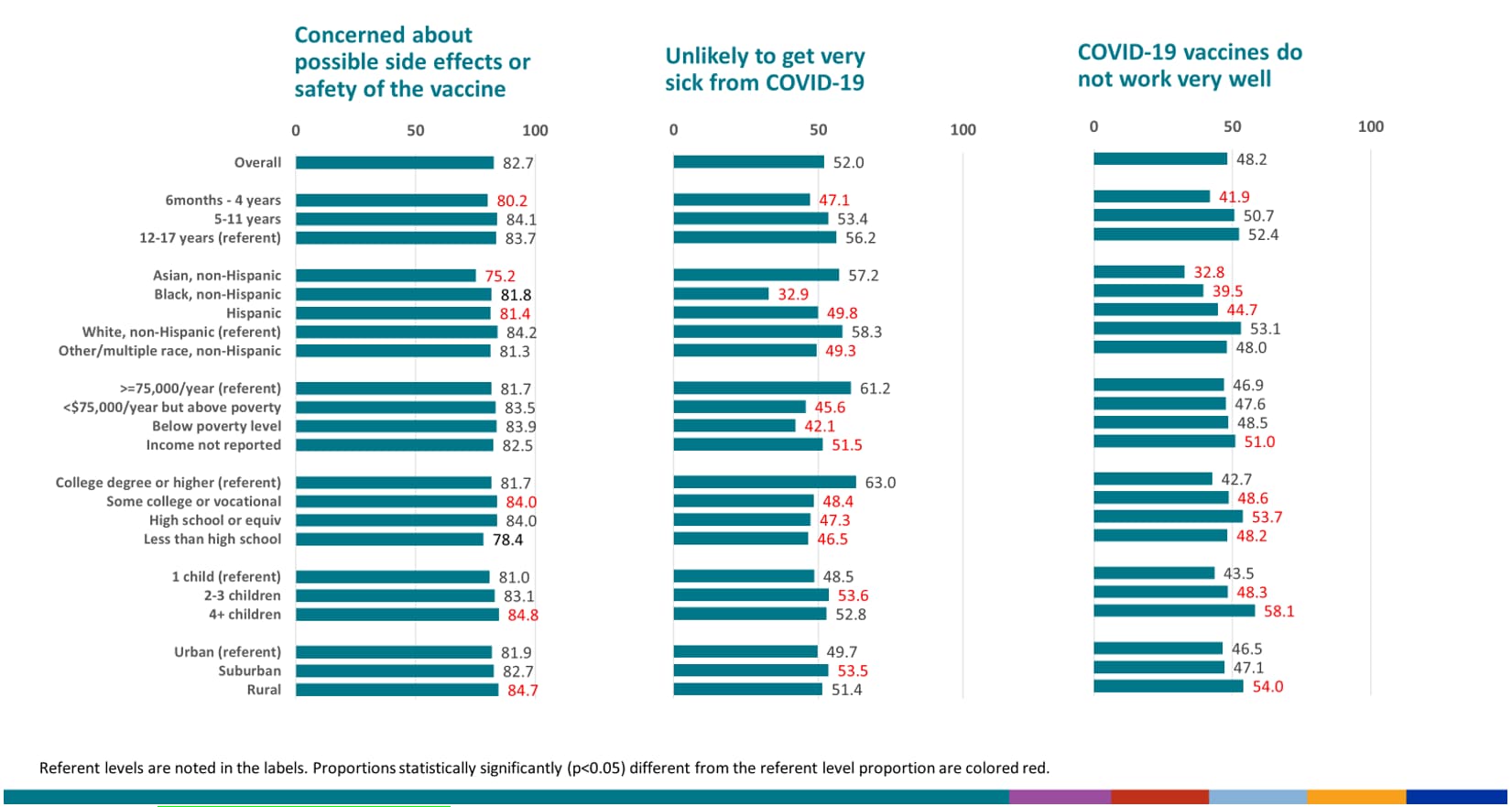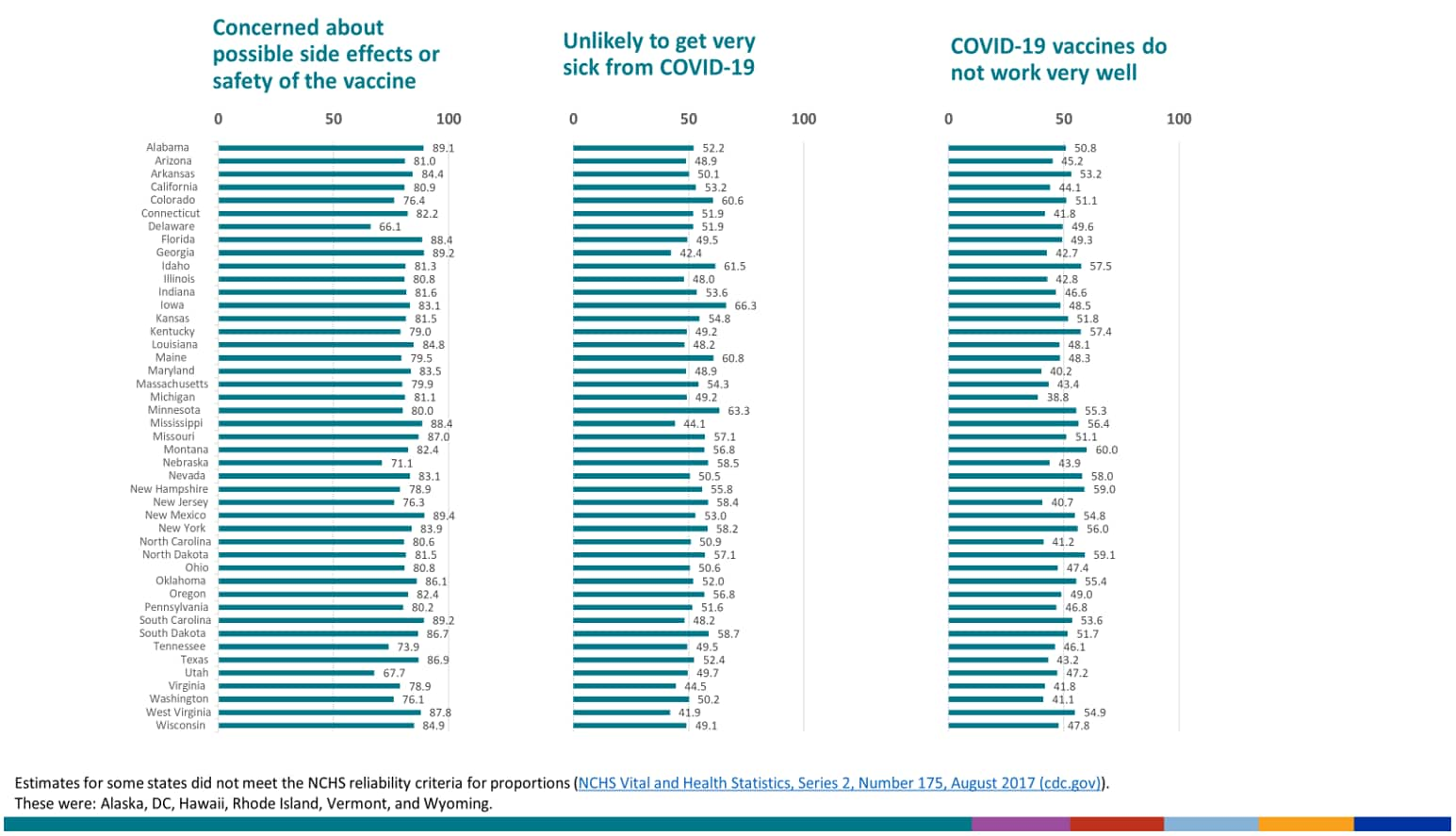At a glance

Background
Less than 15% of children in the U.S. aged 6 months–17 years were up to date on their vaccinations against COVID-19 for the 2023–24 season based on data available on CDC's Weekly COVID-19 Vaccination Dashboard. The percentage of children ever receiving a COVID-19 vaccination is higher, but still represents only half of children (52%), based on estimates available on CDC's Monthly COVID-19 Vaccination Dashboard. Knowing parents' reasons for not having their child vaccinated can help with understanding why COVID-19 vaccination coverage remains low. Parent reporting of any access barriers to vaccinations would be important to know so any barriers could be eliminated. Quantifying reasons given by parents related to beliefs about the vaccine and disease can help health practitioners in their discussions with parents.
Reasons for non-vaccination
The three most common parental reasons for non-vaccination of children with the 2023–24 COVID-19 vaccine were concern about side effects or safety of the vaccine, belief that COVID-19 is not a serious disease for their child, and not believing the vaccines work well.
Among children aged 6 months–17 years in the United States who had not received a 2023–24 COVID-19 vaccine, 82.7% had a parent report that a reason for non-vaccination was that they were concerned about possible side effects or the safety of the COVID-19 vaccine. Slightly more than half of the children (52.0%) had a parent say they did not think their child would get very sick from COVID-19. Slightly less than half of the children (48.2%) had a parent report they don't believe the COVID-19 vaccine works well as a reason for non-vaccination.
Very few unvaccinated children had a parent report one of the access-related issues as a reason for non-vaccination. 5.0% of children had a parent report that it was too hard to find a time or place to get the child a COVID-19 vaccine and 2.0% of children had a parent report that it costs too much.

These results are based on approximately 18,000 interviews conducted October through December 2023 as part of the National Immunization Survey-Child COVID-19 Module (NIS-CCM). The NIS-CCM was a random-digit-dial survey of households with children aged 6 months through 17 years. The respondent to the NIS-CCM was the parent or guardian who was knowledgeable about the child's vaccination history. The response rate for October–December 2023 was 20.0%. More details about the NIS-CCM and the NIS family of surveys are available on COVIDVaxView.
The questions about reasons for non-vaccination followed the vaccination status question and began with this text: "There are many reasons why parents don't get COVID-19 vaccinations for their children. I am going to read a list of only a few of the many possible reasons why parents may not get a COVID-19 vaccination for their children. Please tell me if each statement is a reason why you did not get a COVID-19 vaccination for your child." The preamble was then followed by: "Was one of the reasons that you did not get a COVID-19 vaccination for your child because" [this was repeated as necessary before each reason]...
..."Your child is unlikely to get COVID-19."
..."Even if your child does get COVID-19, they are unlikely to get very sick from COVID-19."
..."It costs too much to get COVID-19 vaccination."
..."It was too hard to find a time or place to get a COVID-19 vaccination."
..."You or your child don't like needles or shots."
..."You were concerned about possible side effects or the safety of a COVID-19 vaccination."
..."You believe that COVID-19 vaccines do not work very well."
The questions were also asked regarding children who were vaccinated but who did not receive any dose of the 2023–24 COVID-19 vaccine. In these cases, the question wording referred to reasons for not getting "another" COVID-19 vaccination. This report is an analysis of all children who did not receive a 2023–24 COVID-19 vaccine, including those who were never vaccinated and those vaccinated with an earlier dose of a COVID-19 vaccine but not the 2023–24 vaccine.
Proportions are reported along with 95% confidence intervals. T-tests for proportions were used to test for socio-demographic group differences from the selected referent group. Children whose parent reported don't know or refused for a question about a reason for non-vaccination were excluded from analysis for that variable only. All analyses are weighted and conducted using SAS and SUDAAN to take the complex survey into account. The NCHS reliability standards for proportions were used and estimates not meeting the criteria were suppressed.
Differences in reasons by socio-demographic variables
Examining the top three reasons for non-vaccination with the 2023-24 COVID-19 vaccine by socio-demographics shows a few differences.
Most (82.7%) unvaccinated children had a parent who reported being concerned about possible side effects or safety of the vaccine. The percentages of parents who reported this reason were high in all sociodemographic groups. The few sociodemographic group differences found were small.
Larger sociodemographic differences were found in the reason of being unlikely to get very sick from COVID-19. Non-Hispanic White children and children who have a mother with higher education level or a higher household income had higher proportions with parents giving this reason. Other differences are noted in red font in the figure below.
Sociodemographic variability was also found in the reason of not believing the vaccine works very well. Non-Hispanic White children, children who have a mother with lower education level, and children residing in rural areas had higher proportions with parents giving this reason. Other differences are noted in the figure.

Variability in reasons by state
Examining these top three reasons for non-vaccination by state showed some variability.
While statistical tests were not done to compare states, the figure shows that there is variability between states in the proportion of unvaccinated children whose parents give these reasons for not vaccinating their child against COVID-19.

Additional Resources
COVID-19 vaccination coverage estimates with the 2024–25 vaccine will be posted on COVIDVaxView. More information about the surveys on which the estimates are based is available on the National Immunization Survey webpage. More information about respiratory diseases in general can be found on CDC's website.
